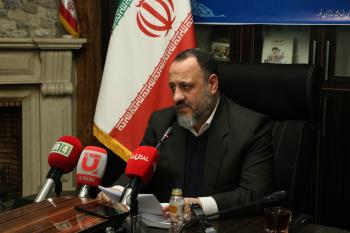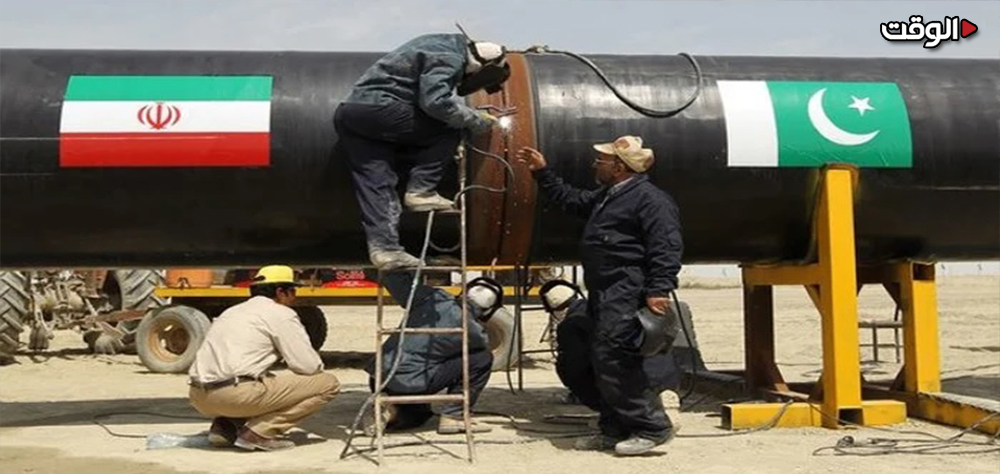Pakistan's efforts to invest in the Peace Pipeline not only bring hope to millions of Pakistani households but also signal a significant change in the region's energy dynamics, offering prospects for a fresh era of cooperation and economic advancement among neighboring countries.
ALWAGHT- After two decades since the agreement was signed, prospects for revitalizing the Iran-Pakistan Peace Pipeline (IP) project are now emerging.
Pakistan has opted to complete the gas pipeline project from Iran in two phases within its borders. Consequently, the Special Investment Facilitation Council of Pakistan (SIFC) has sanctioned a plan to initially develop 81 kilometers as part of the overall 781-kilometer pipeline, which will eventually link up with Nawabshah.
In this context, the 'Oil Division' is poised to secure necessary approvals from the federal cabinet for the execution of the 81-kilometer pipeline, while the Ministry of Finance will ensure the required budget from the Gas Infrastructure Development Cess (GIDC) board. Islamabad authorities state that the 81-kilometer pipeline will connect Gwadar to the Iran-Pakistan gas pipeline project, facilitating gas usage in Gwadar.
Pakistan's recent efforts to rejuvenate this pipeline coincide with Iran's previous issuance of a 180-day ultimatum to Pakistan until September 2024 to construct the pipeline. Failure to do so would subject Pakistan to an $18 billion penalty from Tehran under an international jurisdiction based in Paris.
Nevertheless, Iran has also extended its legal and technical assistance to Pakistan to collaboratively devise a mutually beneficial strategy before the expiration of the 180-day deadline to avert this issue.
The decision by Iran to invoke the penalty clause in the gas purchase agreement signed by both countries in 2009 exerted pressure on the Pakistani government, prompting the dispatch of an official delegation to Iran late last year. Islamabad officials stressed that the construction of this pipeline is of paramount importance to the government and is deemed the sole solution to meet the nation's energy demands.
The Peace Pipeline is a gas export initiative from Iran to India and Pakistan, with Iran committing to supply gas to these countries at a predetermined price over a 25-year period. This route stands as the most cost-effective means of energy supply to the Indian subcontinent. The Iran-to-India pipeline spans 2,700 kilometers, with initial agreements specifying 1,100 kilometers in Iran, 780 kilometers in Pakistan, and 600 kilometers in India.
Upon project completion, Iran was slated to export 150 million cubic meters of gas daily to India and Pakistan, with 90 million cubic meters earmarked for India and 60 million cubic meters for Pakistan. While the initial cost estimate for the project was $4.5 billion, experts now project it to be around $7 billion.
Commencing in 2002, the construction of this pipeline was slated for completion in 2014. However, India's withdrawal from the project and Pakistan's delay in constructing the pipeline within its borders led to its abandonment.
The primary reason for India and Pakistan's withdrawal from the gas project stemmed from economic sanctions imposed by the United States against Iran, pressuring both nations to refrain from participating in the Peace Pipeline. Nonetheless, with shifting global dynamics and the diminishing efficacy of Western sanctions, Pakistan has once again expressed interest in the project.
Is Pakistan's decision strategic or tactical?
While Pakistan may aim to demonstrate its unwavering dedication to completing this pipeline, the adoption of a strategic and forward-thinking approach by its eastern neighbor, along with steadfast execution of the project, would also promote economic growth, enhance energy security, and foster prosperity in the region.
Hence, the project's success hinges on timely completion and the ability to overcome potential obstacles to avoid future arbitration and financial penalties. Following Pakistan's recent decision, Iran might postpone the arbitration process depending on Pakistan's progress. However, if Islamabad once again delays fulfilling its commitments, Tehran could enforce the hefty $18 billion penalty on crisis-stricken Pakistan, which has recently sought loans from international financial institutions to alleviate severe financial crises.
On the flip side, considering alternative projects like the TAPI pipeline involving Turkmenistan, Afghanistan, Pakistan, and India proposed over the past two decades, Pakistan must ensure adherence to gas agreements with Iran, regardless of the advantages offered by other energy transit routes. In 2017, Pakistan faced pressure from Saudi Arabia to suspend gas agreements with Qatar, indicating the potential for external pressures in the Peace Pipeline project as well.
The Peace Pipeline fulfills Pakistan's requirements
The decision to put into operation the gas pipeline project signifies a fundamental shift in bilateral relations, marking the onset of a fresh era of collaborative endeavors.
Indeed, Pakistan's recent decision goes beyond a mere procedural measure, indicating a dedication to shared objectives and economic advancement. Iran's extension until September 2024, along with offers of legal and technical support, underscores a level of involvement transcending mere transactional engagements, promising favorable outcomes for energy ties and regional stability.
The significance of this pipeline cannot be overstated; it acts not only as a conduit for natural gas but also as a crucial lifeline for Pakistanis contending with energy deficits. The port of Gwadar, strategically positioned in the Arabian Sea, will serve as the entry point for gas transmission from Iran, exemplifying the joint efforts of both nations to address energy disparities by pooling resources, expertise, and goodwill.
According to Rizwan Shah, a Pakistani analyst, "The completion of this pipeline signals the start of an economic resurgence in Pakistan, where households stand to benefit from the advantages of affordable energy."
He further suggests, "While the Pakistan-Iran gas pipeline project marks a significant stride in addressing immediate energy requirements, it also prompts reflection on the importance of developing local energy resources. By tapping into domestic resources and broadening energy sources, Pakistan can pave the way for a future less reliant on foreign energy. Thus, this project is not solely about securing energy from Iran but also about fostering broader discourse on energy autonomy and sustainability."
Competing against India
Pakistan's delayed endeavors to finalize this pipeline stem not just from bolstering collaboration with the Islamic Republic but also from shifts in the regional landscape.
With neighboring countries making inroads into the Iranian market in recent years, securing trade shares through enhanced economic bonds, Pakistan is prioritizing the cultivation of ties with Tehran to avoid lagging behind.
Pakistan apprehends that India's strengthened rapport with Iran and its substantial investments in Chabahar Port and rail links bridging the Indian Ocean to Central Asia pose challenges. Consequently, Islamabad seeks to mitigate potential hindrances to the pipeline project's progression.
According to the pipeline accords, gas ultimately needs to be transported from Pakistan to India, prompting Islamabad to accelerate project completion to tap into revenues if gas continues flowing to India.
Pakistan fears that delay in pipeline construction could prompt India to reroute Iranian gas through alternative channels, thwarting Pakistan's prospects of earning dollar revenues from this more direct pipeline pathway.
Alternatively, if Pakistan assumes the role of the exclusive conduit for Iranian gas to India, it can utilize this transit advantage during tense moments and conflicts with its eastern neighbor to exert greater influence over Delhi.
As a result, Pakistan, while enhancing its trade ties with China to construct infrastructure aimed at challenging India's economic strategies, concurrently pursues a strategic deepening of engagement with Tehran to bolster its significance in regional dynamics amidst internal challenges.
In summary, the gas pipeline initiative stands as a testament to the evolving cooperation between Iran and Pakistan. Both nations are steadfast in their determination to ensure the success of this project, aiming not only to address the energy crisis but also to lay the groundwork for a prosperous, stable, and self-reliant future.
With the completion of the Peace Pipeline and the activation of economic partnerships, a significant transformation in the energy landscape is inevitable in the years ahead, marking the onset of a fresh era of collaboration and economic progress among neighboring nations.



























